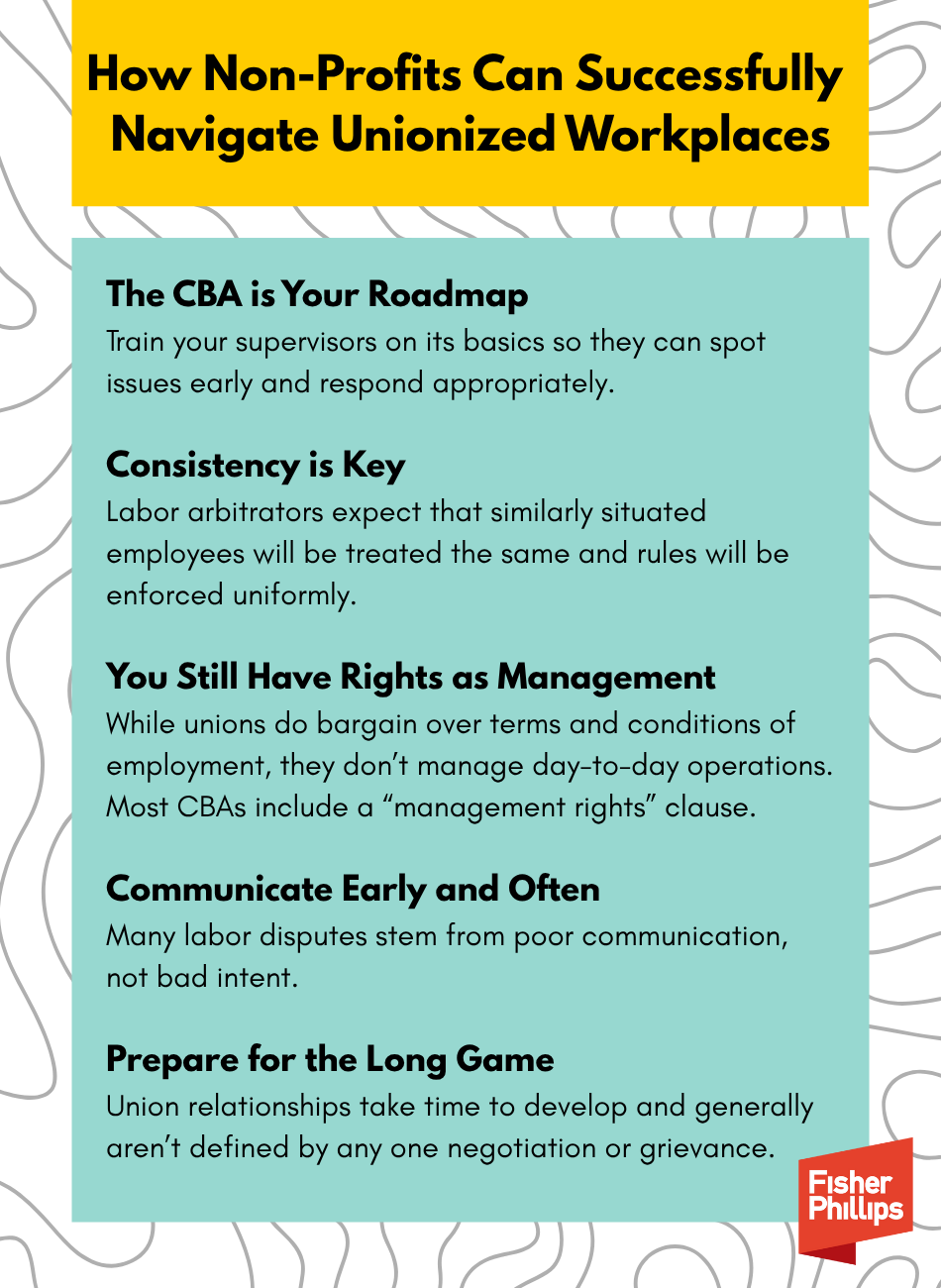Beyond the Bargaining Table: How Non-Profits Can Successfully Navigate Unionized Workplaces
Insights
7.15.25
If you're a non-profit leader, chances are you wear many hats: fundraiser, mission champion, crisis responder, community builder. But if your workforce is unionized, there’s another important hat that you may need to wear: labor partner. Managing a unionized workforce can feel daunting for non-profits, especially those with informal work cultures that are new to collective bargaining relationships. However, it doesn’t have to be overwhelming. With a bit of planning, communication, and consistency, you may be able to improve your dealings with the union. Here are five practical pointers for non-profit employers to successfully manage in a unionized environment.
1. The Collective Bargaining Agreement (CBA) is Your Roadmap
The CBA is your working guide for how your organization and the union interact. It typically governs wages, benefits, schedules, discipline, grievance procedures, and more. However, many non-profit managers make the mistake of only dusting it off when there’s a problem. Instead, get to know it proactively. Understand key deadlines, notice requirements, and management rights clauses. Train your supervisors on its basics so they can spot issues early and respond appropriately.
Keep in mind that interpreting a CBA is not always straightforward. If you’re unsure whether a policy or disciplinary action is covered, ask your trusted labor counsel for help. A small question now can prevent a major grievance later.
2. Consistency is Key
Consistency is essential in a unionized environment. Labor arbitrators expect that similarly situated employees will be treated the same and rules will be enforced uniformly. This means your managers should follow written policies, document disciplinary actions, and avoid making exceptions “just this once.” For many organizations, this requires a mindset shift to a more formal style of management that relies on written documentation of key actions, such as supervisory counseling and discipline.
This doesn’t mean you lose all flexibility. Many CBAs extend a great deal of latitude in that regard. But exercising that flexibility should be thoughtful, documented, and ideally discussed with HR or legal counsel if there’s any gray area.
3. You Still Have Rights as Management
Some non-profit leaders worry that a unionized workforce limits their ability to manage. While unions do bargain over terms and conditions of employment, they don’t manage day-to-day operations.
Most CBAs should include a “management rights” clause that preserves your authority to set strategic direction, assign work, make hiring decisions, and enforce policies. You should note, however, that these rights aren’t unlimited, and they must be exercised in line with the contract and applicable law.
If you're making a change that might impact employees – like restructuring roles or adjusting schedules – ask whether it triggers a bargaining obligation. You may not need to bargain over the decision itself, but you may need to bargain over the effects. Understanding the line between what’s negotiable and what’s managerial is key.
4. Communicate Early and Often
Labor-management relationships thrive on communication. Many labor disputes stem from poor communication, not bad intent. So, when issues do arise, clear communication may help.
- Don’t wait for negotiations or grievances to engage the union.
- Develop a practice of open communication with union representatives and provide them updates about organizational changes.
- Consider establishing regular check-ins or labor-management committees to address issues before they escalate. At these meetings, listen to their concerns and clarify misunderstandings early.
5. Prepare for the Long Game
Union relationships take time to develop and generally aren’t defined by any one negotiation or grievance. If you’re heading into bargaining for the first time, expect it to be a learning process. It may take longer than you’d like, and emotions can run high. That’s normal.
Prepare by assembling a thoughtful bargaining team, reviewing your operational needs, and gathering relevant data. Know your goals, limits, and must-haves. Be clear, patient, and willing to listen.
Also, remember that the relationship continues after a contract is in place. Invest in training your supervisors to understand the agreement and avoid “past practice” pitfalls that can arise when exceptions become habits. You’ll also want to keep good documentation.
Most of all, be sure to stay mission-focused. Remind everyone that the ultimate goal is to create a stable, respectful workplace that allows your organization to serve the community effectively.
Conclusion
With knowledge, consistency, and communication, you can maintain a unionized workplace where staff and leadership work together toward your shared goals. An attorney who understands non-profit dynamics can be an invaluable partner in helping you resolve issues before they become problems. If you have questions, please contact your Fisher Phillips attorney, the author of this Insight, or any member of our Non-Profit Organizations Team or Labor Relations Practice Group. Make sure you are subscribed to Fisher Phillips’ Insight System to gather the most up-to-date information.
Related People
-
- Pawel Z. Binczyk
- Partner

